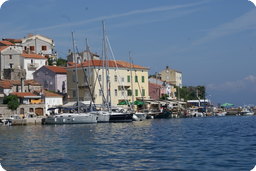

Valun/island of Cres
Valun/island of Cres  The Valun tablet
The Valun tablet

An outing to Valun on the island of Cres is always a happy day in your life, a day full of surprises, splendid images, wonderful scenery and meetings with uncommonly kind people. For food lovers, it is also a lavish plate of island lamb served with spring onions or a plate of good grilled sea fish which has to swim in wine after it has come out of the sea. However, I also have something to say to those of you who are not into food so much, with all due respect to what is on offer in the taverns and inns in Valun, but are looking for other pleasures, such as culture or history. Valun is known for the Valun Tablet. When you lay eyes on this tablet in Valun Parish church, there is no telling what your reaction might be: disappointment or enthusiasm. When one speaks of tablets in the context of history or archaeology, one is always expecting to see a nicely engraved, carefully cut, perfectly shaped stone tablet with ceremonial, impressive and perfectly chiselled letters. However, there is none of that on the Valun Tablet.
It is a common piece of local stone of the kind that can be found even nowadays, spotted, recognised and picked up in the islands' karst terrain. There is something rudimentary and timeless about it. A long time ago, someone's eye spied it, and someone's hands dug it out and used it as a suitable slab to cover a grave in which three generations were buried: a grandmother, her son and grandson. It is written on it that the grandmother's name was TEHA, her son's name was BRATOHNA and the grandson's JUNA. This was written in two different languages and scripts. In Croatian and glagolitic script it reads: TEHA, SIN, VNUK JUNA. In Medieval Latin it reads: TECHA ET FILIUS EIUS BRATOHNA ET IUNNA NEPUS EIUS
In translation it reads: Teha and her son Bratohna and Juna, her grandson. These are neither Peters nor Pauls of the Christian calendar, but intimate, native, old Croatian folk names. Male and female. The palaeographical characteristics of the glagolitic letters on the Valun Tablet indicate their link to the oldest, so-called round glagolitic script, which is older than the form used on the Baška Tablet. It has been dated to the 11th century. As for the Latin letters, these are the so-called Caroline letters that were common in the West between the 9th and 12th century. The question naturally arises: why are there two languages and two scripts on the Valun Tablet: an inscription in Croatian and glagolitic letters and another in Medieval Latin in Caroline letters? The reason is of a very practical nature. In those times, in the 11th century, when the Valun Tablet was inscribed, the island of Cres was inhabited by two peoples: the indigenous Roman people who spoke some kind of island Latin dialect and the new immigrants, the Croatians. The Valun Tablet truly mirrors ethnic and linguistic coexistence and cohabitation on the island of Cres in those times. The writings of Deacon Ivan (Ivan Đakon) from 1100 are now clear, for he mentioned in his manuscript Chronicon Venetum, that the Venetian Doge Pietro II Orseolo was welcomed and greeted in the city of Osor by: "non modum cives, verum omnes de finitimis quam Romanorum tam Sclavorum Castellis convenientes" - "not only the citizens of Osor but also those who came from Roman as well as Slav castles." This is a picture of the ethnic situation on the islands of Cres and Lošinj at the time the Valun Tablet was made.
Source: http://domovina.110mb.com
From the book TERRA INCOGNITA by Branko Fučića
The Valun Tablet is displayed in Valun Church and there is a replica in Toš tavern.
Video
Current news
 Macrocruise charter agency
Additional discount on the boat rental price of betw
Macrocruise charter agency
Additional discount on the boat rental price of betw




























